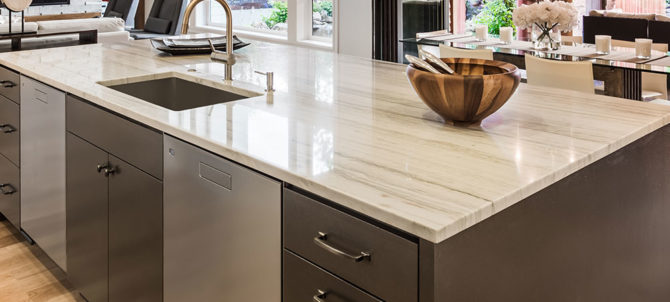
Countertops are the foundational feature of a busy kitchen, and keeping them in a condition where they’re as beautiful and bright as when you first got them is crucial not only for maintenance purposes but also because they bring character to your cooking space.
Unfortunately, due to the busy nature of the kitchen, most countertops tend to develop stains. Thankfully, you can remove these stains.
To help you out, here are some of the best tips to resort to, depending on the type of countertop you have, to guarantee that your kitchen looks great with no stains or markings that could depreciate its value.
Laminate countertops
Laminate countertops are made of plastic resins and are extremely stain-resistant. If you have a stain or mark from a spill or slip, spray a baking soda and water solution over the area before wiping with a clean cloth.
The most common cause of laminate damage is laying hot pots or pans on the surface, which can cause stains.
Coffee, wine, ink, and food stains are the most common on laminate counters. Depending on the type of stain, the procedure you employ to remove it may differ.
Begin by blotting the stain with a clean, dry cloth or paper towel if it is still new. Rubbing the discoloration will only push it deeper into the laminate, so don’t do it.
After blotting the stain, prepare a cleaning solution. The solution you prepare depends on the type of stain you have.
Combine warm water and a few drops of mild dish soap to remove general stains.
For grease stains, use warm water mixed with a few drops of dish soap or a grease-cutting cleanser.
To remove stubborn stains, prepare a baking soda and water paste.
Rub rubbing alcohol or acetone (nail polish remover) on ink stains. Apply a small amount on a cloth and dab the stain gently.
To avoid stains in the future and protect your countertops, wipe up spills immediately, protect the surface with cutting boards and hot pads, and avoid using harsh abrasives or scouring pads.
You also should make it a habit to use coasters or trivets at all times before placing anything down.
Quartz countertops
Because of their non-porous nature, quartz countertops are easy to maintain in terms of stain resistance. Since they are scratch-resistant, you can put almost anything on them.
Although quartz worktops are durable and stain-resistant, they can become damaged if spills are allowed to rest for an extended period of time. Thankfully, there are several ways of getting off the stains when they happen.
Start by preparing a cleaning solution. The solution you prepare depends on the type of stain you have.
Combine warm water and a few drops of mild dish soap to remove general stains. This solution will remove most of the stains on your countertops.
To remove stubborn stains, make a paste by combining baking soda and a tiny amount of water.
For oil-based stains such as grease or frying oil, use a 70% isopropyl alcohol and 30% water solution.
A 1:1 mixture of hydrogen peroxide (3-10%) and water is ideal for organic stains such as coffee, tea, or wine.
You can also use rubbing alcohol or acetone to remove ink stains.
To avoid future stains, wipe up spills as soon as they happen, protect the surface with cutting boards and hot pads, and avoid harsh abrasives or scouring pads.
Marble countertops
Because marble is porous, it is considered a ‘soft’ stone. The stone’s porous nature means it is easily damaged and stained.
You should start by blotting the stain with a clean, dry cloth or paper towel if the stain is new. Avoid touching the discoloration because it will spread.
To remove stubborn or deep stains, make a poultice. A poultice is a material that draws stains from the stone’s pores. The poultice you prepare depends on the stain you want to remove.
For organic stains (such as coffee, tea, and wine), make a thick paste by combining baking soda and water.
For oil-based stains (for example, grease), make a paste by combining baking soda and acetone or mineral spirits.
You can use acetone or hydrogen peroxide to remove ink stains.
Spread the poultice over the stained area, allowing it to spread slightly beyond the stain’s margins. To establish an airtight seal, wrap it in plastic wrap and glue the edges down. Allow it to sit for 24 to 48 hours, depending on the degree of the stain.
To avoid future stains, seal your marble countertop regularly (every 6-12 months, depending on use), and use cutting boards and hot pads to protect the surface. You also should make it a habit to wipe up any spills as soon as they happen.
Concrete Countertops
Since concrete is a porous material, it’s highly susceptible to staining.
You should create a cleaning solution appropriate for the stain you want to remove.
Combine warm water and a few drops of dish soap to remove general stains.
To remove stubborn stains, make a paste by combining baking soda and a tiny amount of water.
For oil-based stains, combine warm water with a few drops of dish soap, or use a 3-part water/1 part ammonia solution.
For the grease stains, remove them using ammonia.
Soak a cloth or sponge in 3 percent hydrogen peroxide to remove ink stains and lay it over the spot. To keep it moist, cover it in plastic wrap. Allow it to sit for a couple of hours or overnight.
After preparation, apply the cleaning solution to the stained area.
Clean and reseal the countertop regularly to prevent future stains from your kitchen countertops Durham. Use cutting boards and hot pads to protect the surface, and mop up spills immediately afterward.